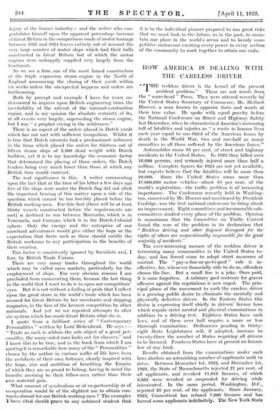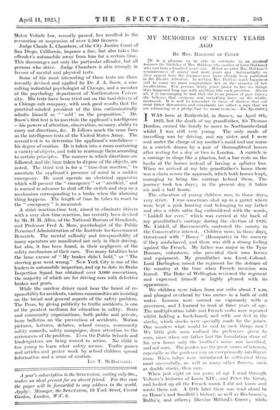HOW AMERICA IS DEALING WITH : THE CARELESS DRIVER •
•
" THE reckless driver is the kernel of the present accident problem." These are not words from the " scare-head " Press. They were uttered recently by the United States Secretary of Commerce, Mr. Herbert Hoover, a man known to appraise facts and words at their true value. He spoke with equal gravity before the National Conference on Street and Highway Safety' last December, when he 'characterized America's increasing toll of fatalities and injuries as " a waste in human liven each year equal to one-third of the American losses by death in the World War, two and one-half as many casualties as all those suffered by the American forces."
Automobiles cause 85 per cent. of street and highway accidents in the United States. In 1923 they killed over 16,000 persons, and seriously injured more than half a- million. Complete figures for 1924 are not yet available, but experts believe that the fatalities will be more than 20,000. Since the United States owns more than 17,000,000 motor vehicles—about 88 per cent. of the world's registration—the traffic problem is of increasing importance. The Conference recently held in Washing-- ton, conceived by Mr. Hoover and sanctioned by President Coolidge, was the first national endeavour to bring about an improvement. Eight committees and innumerable sub- committees studied every phase of the problem. Opinion' is unanimous that the Committee on Traffic Control• found the core of the problem in -.its declaration that " Reckless driving and other flagrant disTegard for the rights of others are unquestionably responsible for the great majority of accidents."
The ever-increasing menace of the reckless driver is terrorizing many communities in the United States to day, and has forced some to adopt strict measures of control. The " pay-azfine-or-go-to-gaol " rule is in- effective, for, whenever financially able to do so, offenders choose the fine. But a small 'fine is a joke. Once paid, - it is soon forgotten. A salutary gaol sentence for graver offences against the regulations is now urged. The prin- cipal phase of the movement to curb the -careless driver is a groWing public desire to eliminate the mentally and physically defective driver. In the Eastern- States this desire is expressing itself chiefly in drivers' licence laws which require strict mental and physical examinations in addition to a driving 'test. -Eighteen- States have such laws, and of these over half require a more or less- thorough examination. Ordinances pending in thirty- eight State Legislatures will; if adopted, increase to- twenty-three the- number of States requiring all drivers to be licensed. Fourteen States have at present no licence law of any kind.
Results obtained from the examinations under such laws disclose an astonishing number of applicants unfit to drive. Between December 1st, 1922, and December 1st, 1923, the State of Massachusetts rejected 21 per cent. -of all applicants, and revoked 11,613 licences, of which 3,335 were revoked or suspended for driving while intoxicated. In the same period, Washington, D.C.; rejected 26 per cent. of the applicants. Since January, 1925, Connecticut has refused 7,000 licences and has barred some-applicants indefinitely. The New York State Motor Vehicle law, recently passed, has resulted in the revocation or suspension of over 2,500 licences.
Judge Claude L. Chambers, of the City Justice Court of San Diego, California, imposes a fine, but also takes the offender's automobile away from him for a certain tune. This discourages not only the particular offender, but all persons who drive. Judge Chambers is also strongly in favour of mental and physical tests.
Some of the most interesting of these tests arc those recently devised and applied by Dr. J. A. Snow, a con- sulting industrial psychologist of Chicago, and a member of the psychology department of Northwestern Univer- sity. His tests have been tried out on the taxi-drivers of a Chicago cab company, with such good results that the practical-minded president of the firm enthusiastically admits himself as " sold ' on the proposition." Dr. Snow's first test is to ascertain the applicant's intelligence —his powers of attention, observation, memory, ability to carry out directions, &c. It follows much the same lines as the intelligence tests of the United States Army. The second test is to determine the applicant's carefulness— his degree of caution. He is taken into a room containing a variety of objects, and told to rearrange them according to certain principles. The manner in which directions are followed, and the time taken to dispose of thc objects, arc noted. The third test is for a " time-fear reaction," to ascertain the applicant's presence of mind in a sudden emergency. He must operate an electrical apparatus which will present the " emergency " or " accident," and is warned in advance to shut off the switch and step on a mechanism corresponding to a brake when the alarming thing happens. The length of time he takes to react to the " emergency " is measured.
A strict reaction-time test, aimed to eliminate drivers with a very slow time-reaction, has recently been devised by Mr. H. H. Allen, of the National Bureau of Standards, and Professor Fred A. Moss, • psychologist of the Public Personnel Administration of the Institute for Government Research. The mental callosity and irresponsibility of many operators are manifested not only in their driving, but also, it has been found, in their negligence of the safety mechanism of their cars. Too many fatalities bear the lame excuse of " My brakes didn't hold," or " The steering gear went wrong." New York City is one of the leaders in automobile inspection, and "up to date its Brake Inspection Squad has obtained over 3,000 convictions, the majority of which are for driving cars with defective brakes and gears. • While the careless driver must bear the brunt of re- sponsibility for accidents, various communities are insisting on the broad and general aspects of the safety problem. The Press, by giving publicity to traffic accidents, is one of the greatest mediums for education in safety. State and community organizations, both public and private, issue bulletins on the prevention of accidents. Motion pictures, lectures, debates, school essays, community safety councils, safety campaigns, draw attention to the seriousness of the problem. Even the Public Schools and kindergartens are being roused to action. No child is too young to learn what safety means. Traffic games and articles and poster work by school children spread information and a sense of caution.
IAN T. MCDOUGALL.











































 Previous page
Previous page